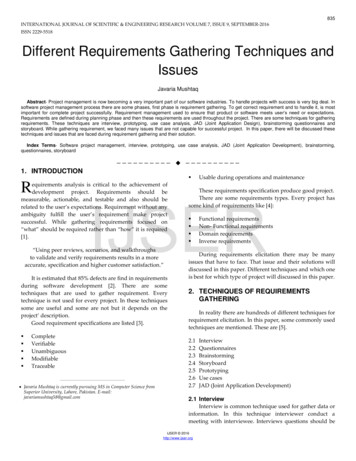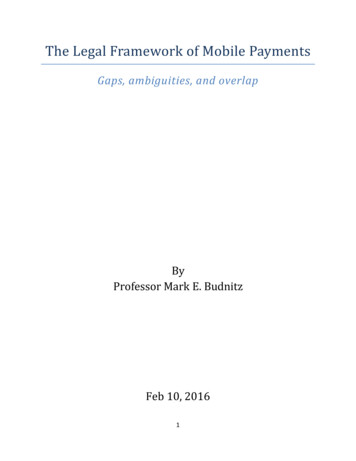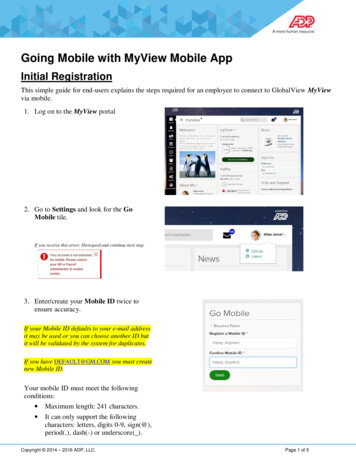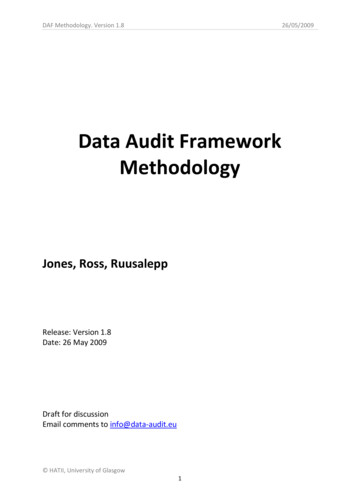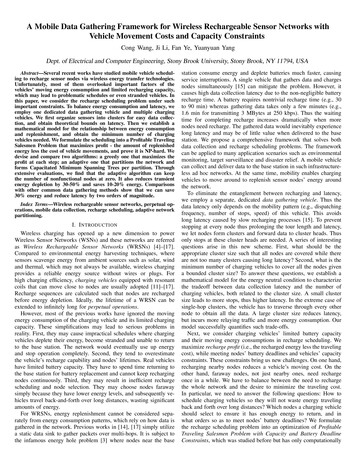
Transcription
A Mobile Data Gathering Framework for Wireless Rechargeable Sensor Networks withVehicle Movement Costs and Capacity ConstraintsCong Wang, Ji Li, Fan Ye, Yuanyuan YangDept. of Electrical and Computer Engineering, Stony Brook University, Stony Brook, NY 11794, USAAbstract—Several recent works have studied mobile vehicle scheduling to recharge sensor nodes via wireless energy transfer technologies.Unfortunately, most of them overlooked important factors of thevehicles’ moving energy consumption and limited recharging capacity,which may lead to problematic schedules or even stranded vehicles. Inthis paper, we consider the recharge scheduling problem under suchimportant constraints. To balance energy consumption and latency, weemploy one dedicated data gathering vehicle and multiple chargingvehicles. We first organize sensors into clusters for easy data collection, and obtain theoretical bounds on latency. Then we establish amathematical model for the relationship between energy consumptionand replenishment, and obtain the minimum number of chargingvehicles needed. We formulate the scheduling into a Profitable TravelingSalesmen Problem that maximizes profit - the amount of replenishedenergy less the cost of vehicle movements, and prove it is NP-hard. Wedevise and compare two algorithms: a greedy one that maximizes theprofit at each step; an adaptive one that partitions the network andforms Capacitated Minimum Spanning Trees per partition. Throughextensive evaluations, we find that the adaptive algorithm can keepthe number of nonfunctional nodes at zero. It also reduces transientenergy depletion by 30-50% and saves 10-20% energy. Comparisonswith other common data gathering methods show that we can save30% energy and reduce latency by two orders of magnitude.Index Terms—Wireless rechargeable sensor networks, perpetual operations, mobile data collection, recharge scheduling, adaptive networkpartitioning.I. I NTRODUCTIONWireless charging has opened up a new dimension to powerWireless Sensor Networks (WSNs) and these networks are referredas Wireless Rechargeable Sensor Networks (WRSNs) [4]–[17].Compared to environmental energy harvesting techniques, wheresensors scavenge energy from ambient sources such as solar, windand thermal, which may not always be available, wireless chargingprovides a reliable energy source without wires or plugs. Forhigh charging efficiency, charging vehicles equipped with resonantcoils that can move close to nodes are usually adopted [11]–[17].Recharge sequences are calculated such that nodes are rechargedbefore energy depletion. Ideally, the lifetime of a WRSN can beextended to infinitely long for perpetual operations.However, most of the previous works have ignored the movingenergy consumption of the charging vehicle and its limited chargingcapacity. These simplifications may lead to serious problems inreality. First, they may cause impractical schedules where chargingvehicles deplete their energy, become stranded and unable to returnto the base station. The network would eventually use up energyand stop operation completely. Second, they tend to overestimatethe vehicle’s recharge capability and nodes’ lifetimes. Real vehicleshave limited battery capacity. They have to spend time returning tothe base station for battery replacement and cannot keep rechargingnodes continuously. Third, they may result in inefficient rechargescheduling and node selection. They may choose nodes farawaysimply because they have lower energy levels, and subsequently vehicles travel back-and-forth over long distances, wasting significantamounts of energy.For WRSNs, energy replenishment cannot be considered separately from energy consumption patterns, which rely on how data isgathered in the network. Previous works in [14], [17] simply utilizea static data sink to gather packets over multi-hops. It is subject tothe infamous energy hole problem [3] where nodes near the basestation consume energy and deplete batteries much faster, causingservice interruptions. A single vehicle that gathers data and chargesnodes simultaneously [15] can mitigate the problem. However, itcauses high data collection latency due to the non-negligible batteryrecharge time. A battery requires nontrivial recharge time (e.g., 30to 90 min) whereas gathering data takes only a few minutes (e.g.,1.6 min for transmitting 3 MBytes at 250 kbps). Thus the waitingtime for completing recharge increases dramatically when morenodes need recharge. The gathered data would inevitably experiencelong latency and may be of little value when delivered to the basestation. We propose a comprehensive framework that solves bothdata collection and recharge scheduling problems. The frameworkcan be applied to many application scenarios such as environmentalmonitoring, target surveillance and disaster relief. A mobile vehiclecan collect and deliver data to the base station in such infrastructureless ad hoc networks. At the same time, mobility enables chargingvehicles to move around to replenish sensor nodes’ energy aroundthe network.To eliminate the entanglement between recharging and latency,we employ a separate, dedicated data gathering vehicle. Thus thedata latency only depends on the mobility pattern (e.g., dispatchingfrequency, number of stops, speed) of this vehicle. This avoidslong latency caused by slow recharging processes [15]. To preventstopping at every node thus prolonging the tour length and latency,we let nodes form clusters and forward data to cluster heads. Thusonly stops at these cluster heads are needed. A series of interestingquestions arise in this new scheme. First, what should be theappropriate cluster size such that all nodes are covered while thereare not too many clusters causing long latency? Second, what is theminimum number of charging vehicles to cover all the nodes givena bounded cluster size? To answer these questions, we establish amathematical model for the energy neutral condition to characterizethe tradeoff between data collection latency and the number ofcharging vehicles, both related to the cluster size. A small clustersize leads to more stops, thus higher latency. In the extreme case ofsingle-hop clusters, the vehicle has to traverse through every othernode to obtain all the data. A large cluster size reduces latency,but incurs more relaying traffic and more energy consumption. Ourmodel successfully quantifies such trade-offs.Next, we consider charging vehicles’ limited battery capacityand their moving energy consumptions in recharge scheduling. Wemaximize recharge profit (i.e., the recharged energy less the travelingcost), while meeting nodes’ battery deadlines and vehicles’ capacityconstraints. These constraints bring us new challenges. On one hand,recharging nearby nodes reduces a vehicle’s moving cost. On theother hand, faraway nodes, not just nearby ones, need rechargeonce in a while. We have to balance between the need to rechargethe whole network and the desire to minimize the traveling cost.In particular, we need to answer the following questions: How toschedule charging vehicles so they will not waste energy travelingback and forth over long distances? Which nodes a charging vehicleshould select to ensure it has enough energy to return, and inwhat orders so as to meet nodes’ battery deadlines? We formulatethe recharge scheduling problem into an optimization of ProfitableTraveling Salesmen Problem with Capacity and Battery DeadlineConstraints, which was studied before but has only computationally
intensive solutions.We propose two efficient algorithms. The first is a simple GreedyAlgorithm that maximizes a charging vehicle’s profit at each step.However, it may lead to long traveling distances. We further proposea three-step Adaptive Algorithm. After collecting recharge requests,it partitions the network into several regions using the K-meansalgorithm [35]. Each charging vehicle is assigned a region and itsmovements are confined within the region, so long-distance travelsare avoided. Then each charging vehicle works independently toconstruct Capacitated Minimum Spanning Trees in its designatedregion where edges in the tree have the minimum traveling cost.This ensures that the charging vehicle’s capacity is not exceeded soit can return to its starting position. Finally, the algorithm performsroute improvements to meet nodes’ battery deadlines. It categorizesnodes according to their lifetimes. An initial route containing nodesthat do not need prioritized recharge is first constructed usingTraveling Salesmen Problem algorithms. Then it inserts nodes thatneed prioritized recharge into the route while ensuring each insertionretains time feasibility of the whole recharge sequence.The contributions are summarized as follows. First, we pointout limitations in the existing works on important issues of datalatency, vehicle’s moving cost, recharge capacity, and their impacton existing recharge scheduling algorithms. We establish a mathematical model to quantify the relationship between data latency andthe number of charging vehicles needed. We also present severaltheoretical results such as node lifetime and adaptive rechargethresholds. Second, we formulate recharge optimization into aProfitable Traveling Salesmen Problem with Capacity and BatteryDeadline constraints, and propose two algorithms. The AdaptiveAlgorithm takes a systematic approach to capture all constraints inthe problem. Finally, we conduct extensive simulations comparingthe two proposed algorithms. Although we are not able to proveapproximation bounds for the Adaptive Algorithm theoretically,simulations show that it is only 1.06 to the optimal solutions andsaves an additional 8% on vehicle’s moving energy compared tothe weighted-sum algorithm in [12]. Moreover, when the numberof charging vehicles is sufficient, the Adaptive Algorithm can keepall the nodes alive at all times. Compared to the Greedy Algorithm,the Adaptive Algorithm can reduce nonfunctional nodes by 30-50%while saving 10-20% energy on charging vehicles. We validate ourtheoretical results and justify the system cost, data latency of ourframework compared to other schemes. To the best of our knowledge, this is the first work to explore recharge schedules when bothcharging vehicles’ energy and dynamic sensor battery deadlines areconsidered. This is also the first work that provides a mathematicalmodel to calculate the minimum number of charging vehicles wheredetailed communication energy consumption is considered.The rest of the paper is organized as follows. Section II presentsliterature reviews of the previous works. Section III outlines theframework, network components and assumptions. Section IV describes the main design of low latency mobile data collection. Amathematical model with a set of theoretical results are derived inSection V. Section VI formalizes the recharge optimization problemand proposes two algorithms. Finally, Section VII provides theevaluation results, Section VIII discusses possible improvements andSection IX concludes the paper.traditional battery-powered WSNs are sought in [4]–[9]. In [4],impact from wireless charging technology on WSNs is studied basedon Powercast device models; the sensor deployment and routingproblems are solved by new heuristic algorithms. In [5], a greedyalgorithm with complexity O(k 2 k!) (k is the number of nodes)was designed to find a recharge sequence to maximize the lifetimesof sensor nodes using Powercast chargers [2]. Although energy ofmobile chargers is considered in [5], no step was taken to minimizethe traveling energy of the chargers. In [6], a joint routing andwireless charging scheme is proposed to improve network utilizationand prolong network lifetime. Similarly, in [7], deployment problemsof wireless chargers are studied to extend network lifetime. Anotherproblem of using sensors’ battery recharge times for localization isstudied in [8]. In [9], safety issues using radiation-based wirelesscharging are studied. The problem is formulated into a placementproblem to guarantee no location is exposed to electromagneticradiation above a threshold. In [10], a similar problem to optimizethe amount of “useful” energy under safety concerns is formulated.In general, these works utilize commercial radiation-based wirelesscharging products to power sensor nodes.However, a limitation of this technique is imposed by FederalCommunication Commission’s (FCC) regulatory maximum effective isotropic radiated power (EIRP) of 4W [18]. Omnidirectionalemitting patterns may further exacerbate charging efficiencies asthe electromagnetic energy attenuates rapidly over distances. As aresult, it can only support low-power, infrequent sensing applicationssuch as temperature reading and is unable to power nodes withmore complicated sensing missions, e.g. imaging, video surveillance,tracking, etc. For this reason, in the rest of this paper, we mainlyfocus on resonant-based wireless charging.II. R ELATED W ORKSA. Radiation-based Wireless ChargingB. Resonant-based Wireless ChargingIn contrast to radiation-based technique, resonant-based wirelesscharging can deliver high amounts of energy at high efficiency [11]–[16]. In [11], batteries can be partially charged and various recharging schemes to traverse the sensing field are explored. In [12], [13],a real-time energy information gathering protocol is proposed toobtain accurate energy status of the network. An on-line algorithmis devised to schedule multiple vehicles to recharge sensor nodes. In[14], a near-optimal solution that dispatches one vehicle to rechargeall sensor nodes is provided. However, data is collected by a staticdata sink, which is less energy efficient. Upon realizing this problem,Zhao et. al [15] use a single vehicle for both wireless chargingand data collection to achieve higher efficiency. An algorithm thatselects recharging nodes is first proposed followed by a systemwide optimization to maximize the network utility. In [16], a similarapproach uses a mobile base station to process data immediatelywithout latency. It requires mobile base station to possess intensivecomputational capabilities for processing and dissemination of gathered data. Designing such mobile entities would incur much highermanufacturing cost. Although some previous works accounted forcharging vehicle’s battery energy [5], their strategy is to simplydirect the vehicle back to the base station when it depletes energy. Inother words, they just passively react upon energy depletion; they donot proactively optimize the recharge schedule under limited energyresources. In contrast, we take a vehicle’s recharge capacity andmoving cost into problem formulations, and consciously optimizethe recharge schedule such that the limited resources are bestutilized.Applications of radiation-based wireless charging have grownrapidly from infancy to maturity recently. Popular commercialproducts from Powercast [2] can provide energy to nodes in afew meters. Extensive efforts applying the technology to renovateC. Mobile Data GatheringHow data is gathered determines energy efficiency and datalatency in the network. Mobile data gathering has been studied extensively [19], [20]. In [19], path-planning algorithms are proposed
TABLE IL IST OF N OTATIONSNotationFig. 1.Illustration of the network architecture and components.for mobile collectors to collect data from sensors through single ormulti-hop relays within a time constraint. In [20], mobile relaysare used for relaying packets from energy-rich nodes to normalnodes, and a joint mobility and routing algorithm is proposed toextend network lifetime. For WRSN, previous works either usesstatic data sink [14], [17], which is less energy efficient, or combinedata gathering and wireless charging on a single vehicle [15], whichincurs high latency. To achieve a balance, we employ a dedicateddata gathering vehicle to overcome these drawbacks.Scheduling mobile data gathering vehicles is studied in [21],[22]. In [21], several scheduling methods are proposed to dispatchvehicles so that no buffer overflow could occur on sensor nodes. In[22], the network is partitioned into different sectors based on nodes’buffer overflow times. A 2D-tree method further partitions usinglocation information within sectors. To guarantee no buffer overflow,the minimum traveling speed of the vehicle is found. However, suchalgorithms may not be applied to WRSN directly. First, vehiclesneed to stop and recharge nodes, which takes significantly longertime than data transmission. Thus vehicles cannot perform datacollection continuously as assumed in these algorithms. Second, theydo not consider vehicles’ traveling costs. Thus a node can be visitedrepeatedly in short intervals, incurring extra energy consumption thatshould be avoided.III. P RELIMINARIESIn this section, we present an overview of the components,network model and assumptions.A. Network ComponentsFig. 1 gives a pictorial illustration of the network. Sensory data isgenerated at normal nodes and aggregated at anchor points (i.e.,cluster heads) in a multi-hop fashion. A data gathering vehicletraverses the sensing field periodically and stops at anchor pointsto collect data. It uploads the collected data to the base station atthe end of each data collection tour. The base station also providesbasic maintenance of the network by offering battery replacement. Itcan be commanded by network administrators remotely to performcomputations such as network partitioning in the Adaptive Algorithm proposed later.Meanwhile, a fleet of charging vehicles query the network forenergy information using the mechanism introduced in [12]. Thecharging vehicles send those queries periodically, make rechargedecisions (i.e., which nodes to recharge, in which order) andrecharge nodes accordingly. Once a charging vehicle fulfills allrequests, it sends out a query to see whether there is new energyrequest. Both types of vehicles return to the base station and havetheir own batteries replaced when their energy is low.NsLckmdret , erecλTcBCsChTrvDefinitionNumber of sensor nodesSide length of squared sensing fieldNumber of clusters in the networkCluster size in terms of communication hop countNumber of charging vehiclesTransmission range of sensor nodesEnergy consumptions for transmitting and receiving a packetEnergy consumption of charging vehicle while movingAverage packet rate of Poisson distributed trafficData collection periodData uploading bit rateBattery capacity of sensor nodesBattery capacity of charging vehiclesRecharge time of sensor’s batteryMoving speed of vehiclesB. Network Model and AssumptionsWe assume a number of Ns sensor nodes are uniformly randomlyscattered in a square sensing field with side length L. Node densitysof the network is ρ NL2 . In this paper, we focus on event-drivensensing applications and assume events occur at every location withequal probability, spatially and temporally independent of each other.Thus, the data generation process can be modeled as a Poissonprocess with average rate λ [25]. All sensors transmit at the samepower level with fixed transmission range dr . The energy consumedfor transmitting/receiving a packet of length l, denoted by et , er , ismodeled as in [26], i.e., et (e1 dαr e0 )l, where e1 is the losscoefficient per bit, α is the path loss exponent (usually from 2 to 4)and e0 is energy consumed on sensing, coding, modulations. In thispaper, we use e0 50 10 8 J/bit, e1 10 10 8 J/bit, α 4.The network is split into a number c clusters. A cluster is formedin a way such that the maximum hop count from a node to the anchorpoint (cluster head) is k. When a node falls within k-hops of multipleanchor points, it will join the cluster with the least number of hops.A data gathering vehicle starts from the base station every Tc timeperiod, stops at anchor point location i for time ti to gather all senseddata and returns to the base station after all anchor points
the tradeoff between data collection latency and the number of charging vehicles, both related to the cluster size. A small cluster size leads to more stops, thus higher latency. In the extreme case of single-hop clusters, the vehicle has to traverse through every other node to obtain all the data. A large cluster size reduces latency,



